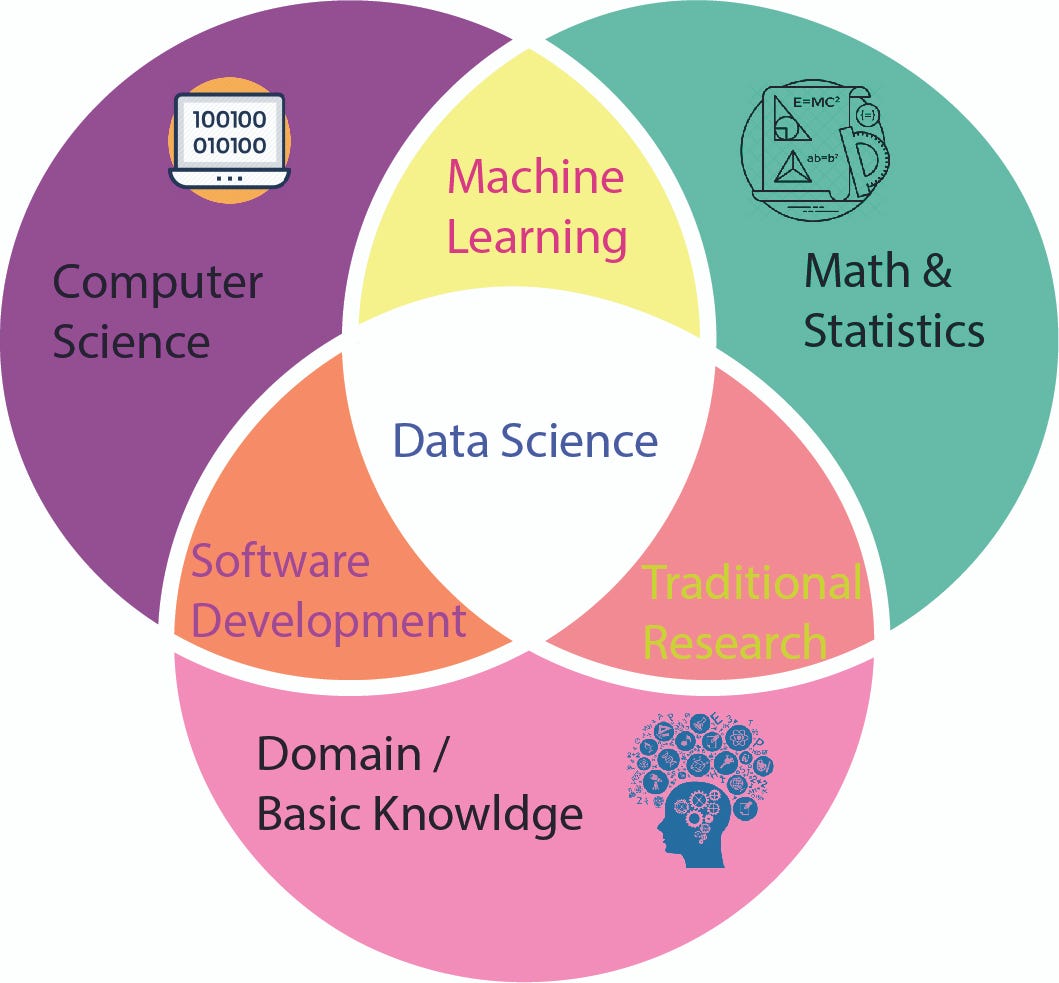Overview scope of the program¶
The Data Science ecosystem¶
Data Science is the art of using data to understand, predict, and solve real-world problems, making it an invaluable tool across all fields for informed decision-making and innovative solutions.

- Domain and Fundamental knowledge: Understanding and expertise in specific subject areas (domains) along with foundational knowledge necessary to comprehend and engage with various disciplines and concepts.
- Computer Science: The study of algorithms, data structures, and computational systems for solving problems and processing information using computers.
- Math & statistics: The discipline that deals with the analysis, interpretation, and manipulation of numerical data, patterns, and relationships, relying on mathematical principles and methodologies.
The data jobs/roles ecosystem¶
Data jobs are becoming increasingly influential in every domain of knowledge due to the widespread adoption of data-driven decision-making. As data-driven approaches offer valuable insights and predictions, professionals with data skills can extract valuable information from data

- Business Analyst: Utilizes data to determine project requirements and provides recommendations and reports to stakeholders, focusing on tactical aspects rather than strategic ones.
- Data Architects and Data Engineers: Data architects visualize framework requirements, while data engineers build the digital framework to create a solution.
- Data Analyst: Analyzes collected data to ensure usefulness and comprehensiveness, interpreting data with strong visualization skills for businesses.
- Data Scientist: Combines technical problem-solving skills with natural curiosity to develop ML models and detect patterns and relationships in copious amounts of data.
- Machine Learning Engineer: Integrates software engineering with machine modeling abilities, determining the appropriate model and data for ML applications.
- Business Intelligence Engineer: Creates unique data visualizations, defining metrics and charts beneficial for business decisions, playing a crucial role in specialized data science models.
The Software ecosystem¶
In this course, we prioritize easy-to-learn and widely used software solutions among the thousands of programming languages, frameworks, and distributions available.
graph TD
PC{Python\n cloud} -.->|connects| GC["✅ Google \n Collab"];
G["☁ Google VM"] -->|has| PC;
YC["💻 Your computer"] -->|has*| AP{Anaconda\n Python};
YC -->|has*| PL{Python\n local};
AP -.->|connects| APJN["✅ Jupyter \n notebook"];
AP -.->|connects| APC["✅ Console:\n Anaconda\n promt"];
AP -.->|connects| API[IDE:\n Spyder];
PL -.->|connects| F[IDE:\n VSCode,\n Pycharm];
PL -.->|connects| YCC["✅ Console:\n cmd,\n powershell"];
GIT -.->|connects| YCB["✅ Console:\n Git Bash"];
YC -->|has*| GIT["✅ GIT"];
GT["☁ GITHUB"] -.->|connects| GIT;Glossary¶
- Google Collab: A free cloud-based platform that allows to write and execute Python code in interactive notebooks using Google's resources.
- Anaconda: A user-friendly Python distribution that bundles essential libraries and tools for data science and machine learning.
- Python: A versatile programming language widely used for various tasks, including data analysis, web development, and automation.
- Jupyter notebook: An interactive environment that lets users write, execute, and visualize code, making it ideal for data exploration and sharing.
- IDE: A software application that provides tools and features to write, edit, and debug code efficiently.
- GIT: A version control system that allows to track changes in their code, collaborate with others, and manage code development effectively.
- Github: A web-based platform that uses GIT for version control and provides a space to store, share, and collaborate on their code projects.
- Console: A text-based interface in an operating system that allows users to interact with the computer through commands, performing tasks such as file navigation, program execution, and system configuration.
The ML ecosystem¶
In this course, we focus on explaining easily understandable supervised and unsupervised machine learning models, as they are commonly used and provide a solid foundation for learning the basics of machine learning.
graph TD
ML[ML models] -->|Labeled data| SML["✅ Supervised models"];
ML -->|Unlabeled data| UML["✅ Unsupervised models"];
ML -->|Time data| TS["Time series"];
ML -->|Reward| RL["Reinforcement learning"];
SML -->|Continuous var| MLR[Regression];
SML -->|Categorical var| MLC[Classification];
UML --> UMLC[Clustering];
UML --> UMLDR[Dimensionality reduction];
MLR --> LR{Linear\n regresion};
MLR --> LRM{Multilinear\n regresion};
MLC --> KNN{KNN};
MLC --> DC{Decision\n trees};
MLC --> RF{Random\n forest};
UMLC --> KMNS{K-means};
UMLDR --> PCA{PCA};